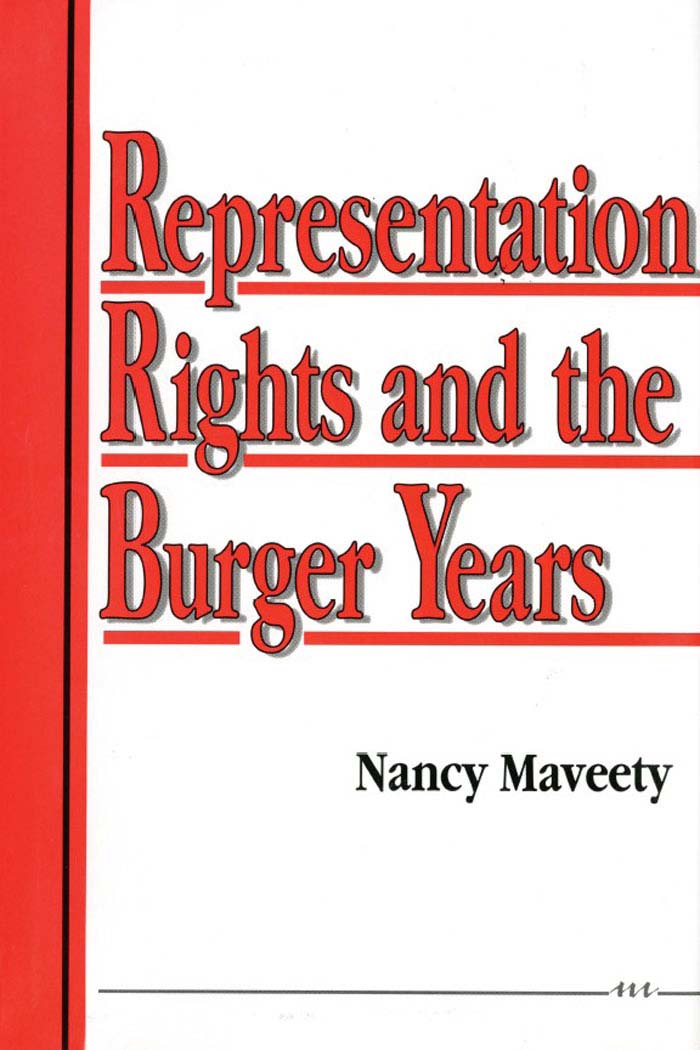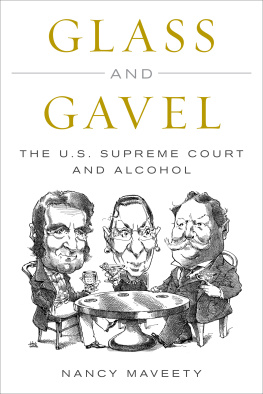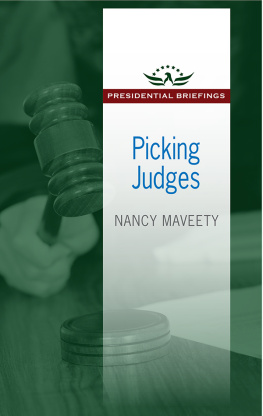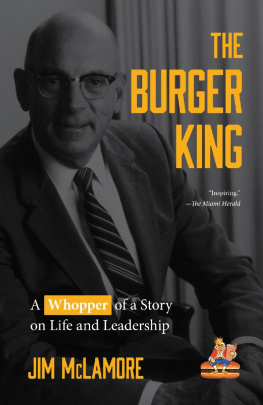Maveety - Representation Rights and the Burger Years
Here you can read online Maveety - Representation Rights and the Burger Years full text of the book (entire story) in english for free. Download pdf and epub, get meaning, cover and reviews about this ebook. year: 1991, publisher: University of Michigan Press, genre: Politics. Description of the work, (preface) as well as reviews are available. Best literature library LitArk.com created for fans of good reading and offers a wide selection of genres:
Romance novel
Science fiction
Adventure
Detective
Science
History
Home and family
Prose
Art
Politics
Computer
Non-fiction
Religion
Business
Children
Humor
Choose a favorite category and find really read worthwhile books. Enjoy immersion in the world of imagination, feel the emotions of the characters or learn something new for yourself, make an fascinating discovery.

Representation Rights and the Burger Years: summary, description and annotation
We offer to read an annotation, description, summary or preface (depends on what the author of the book "Representation Rights and the Burger Years" wrote himself). If you haven't found the necessary information about the book — write in the comments, we will try to find it.
Maveety: author's other books
Who wrote Representation Rights and the Burger Years? Find out the surname, the name of the author of the book and a list of all author's works by series.
Representation Rights and the Burger Years — read online for free the complete book (whole text) full work
Below is the text of the book, divided by pages. System saving the place of the last page read, allows you to conveniently read the book "Representation Rights and the Burger Years" online for free, without having to search again every time where you left off. Put a bookmark, and you can go to the page where you finished reading at any time.
Font size:
Interval:
Bookmark:

Representation Rights and the Burger Years
Nancy Maveety
Ann Arbor
T HE U NIVERSITY OF M ICHIGAN P RESS
Copyright by the University of Michigan 1991
All rights reserved
Published in the United States of America by
The University of Michigan Press
Manufactured in the United States of America
1994 1993 1992 1991 4 3 2 1
Distributed in the United Kingdom and Europe by
Manchester University Press, Oxford Road,
Manchester M13 9PL, UK
Library of Congress Cataloging-in-Publication Data
Maveety, Nancy.
Representation rights and the Burger years / Nancy Maveety.
p. cm.
Based on the authors thesis. Johns Hopkins University.
Includes bibliographical references (p. ) and index.
ISBN 0472102273
1. Apportionment (Election law)United States. 2. Representative government and representationUnited States. 3. United States. Supreme Court. 4. Burger, Warren, 1907 I. Title.
KF4905.M28 1991
342.73'07dc20
[347.3027] | 91616 |
CIP |
British Library Cataloguing in Publication Data
Maveety, Nancy
Representation rights and the Burger years.
1. United States. Representation
I. Title
323.50973
ISBN 0-472-10227-3
ISBN13 978-0-472-10227-3 (cloth)
ISBN13 978-0-472-02268-7 (electronic)
For my father Donald
and my grandmother Theodosia

Preface
My study of the U.S. Supreme Courts contemporary representation policy began as a doctoral thesis at the Johns Hopkins University. Fortuitously, the Burger years came to an end just as I completed my dissertation on the Burger Courts jurisprudence of political representation. Yet, somewhat disconcertingly, the first retrospective studies of the work of the Burger Court were fairly dismissive of its contributions. The Burger years were branded rootlessly activist and directionless and confusedclearly not a period of enduring jurisprudential significance. Indeed, the Burger era seemed quickly forgotten, sandwiched as it was between the liberal activism of the Warren Court and the conservative interventionism of the Rehnquist Court. If the Burger years had meant anything to constitutional law, it seemed to be only in terms of their uniquely indistinctive impact.
I began to despair that any documentation of the substantive contributions of the Burger Court would be dismissed as fanciful. However, because I was confident that the Courts work in the area of representation rights was distinctive and had been influential, I undertook the tortuous process of converting a Ph.D. thesis into a respectable book manuscript. Along the way, I profited greatly from the advice and critical commentary of certain gerrymandering junkiesespecially Dan Lowenstein of the UCLA School of Law, who was a thoughtful and careful reader of the manuscript. In addition, I received valuable encouragement and support from my Ph.D. supervisor, Woody Howard, and my colleagues in political science at Tulane University. The final product is, of course, my responsibility.
Whatever its limitations, the study does communicate one important point: the constitutional discussions of representation rights occurring today are the direct result of developments initiated by the Burger Court. Specifically, the Burger Courts group-balancing approach to representation questions precipitated an ever-expanding judicial role of scrutinizing political institutions and processes, as well as inaugurated the concept of aggregate political rights in constitutional law. Thus, the Burger years were far from unimportant, at least in the area of political representation law.
Why, then, has this judicial era been largely ignored by many scholars? Clearly, the Burger Court lacked the drama of the Warren Courts or the tension of the emergent Rehnquist Court. The Burger Courts work was often typified by the introduction of balancing tests to govern individual rights questions. Balancing usually implied compromise between sets of group interests and accommodation between political viewpoints. Indeed, the Burger Court was a quintessentialy pluralist court. As such, both its jurisprudential record and its institutional personality were subtle and understated. Yet, despite its self-effacing juridical presence, the Burger Courts balancing doctrines continue to inform current constitutional adjudication. This is nowhere more true than in the area of representation rights.
Representation is itself a perplexing issue in constitutional law. Until 1962, many issues of electoral participation were constitutionally off limits because of the Courts political question doctrine. When the Warren Court finally began to scrutinize participation opportunities as equal protection and First Amendment issues, it announced that the Constitutions objective was, among other things, a system of fair and effective representation. Yet the implications of this requirement were not fully understood until the Burger years. During the Burger era, the constitutional definition of political representation and the scope of actionable political access problems were substantially broadened. Because of these developments, representation rights are now more group-oriented and more concerned with the actual processes of effective political action. This legacy even if ultimately repudiatednecessarily influences both the work of the Burger Courts successors and the politys dialogue about meaningful representation and political equality.
It is perhaps unusual for an author to acknowledge indebtedness to particular scholarly works, but my own examination of representation rights during the Burger years was inspired by two works that deserve recognition. Although reflecting somewhat different political positions and disciplinary approaches, both Hanna Pitkins Concept of Representation and Ward Elliotts Rise of Guardian Democracy enabled me to appreciate that constitutional questions are very much issues of democratic theory. While the latter seems a fairly pedestrian insight, it is sometimes forgotten by both scholars of judicial policy-making and specialists in representation law. A synthesis between the objectives of legal analysis, political theory, and political science is what I hope this study accomplishes; to the extent that it does, I am indebted to Colin Day, director of the University of Michigan Press, to Paul Betz, and to an anonymous reader.
CHAPTER 1

Representation
For the past twenty-five years the U.S. Supreme Court has been struggling to provide a constitutional definition for political representation. For almost as long, legal commentators have been struggling to interpret the meaning and implications of the Courts decisions. Although the Warren Courts famous pronouncement of one person, one vote is part of our political vocabulary, its parallel goal of fair and effective representation remains more elusive. The numerically equal vote standard, announced in Reynolds v. Sims in 1964, was a radical reformulation of the American conception of
Font size:
Interval:
Bookmark:
Similar books «Representation Rights and the Burger Years»
Look at similar books to Representation Rights and the Burger Years. We have selected literature similar in name and meaning in the hope of providing readers with more options to find new, interesting, not yet read works.
Discussion, reviews of the book Representation Rights and the Burger Years and just readers' own opinions. Leave your comments, write what you think about the work, its meaning or the main characters. Specify what exactly you liked and what you didn't like, and why you think so.










